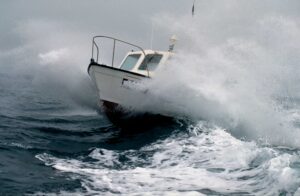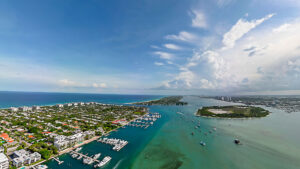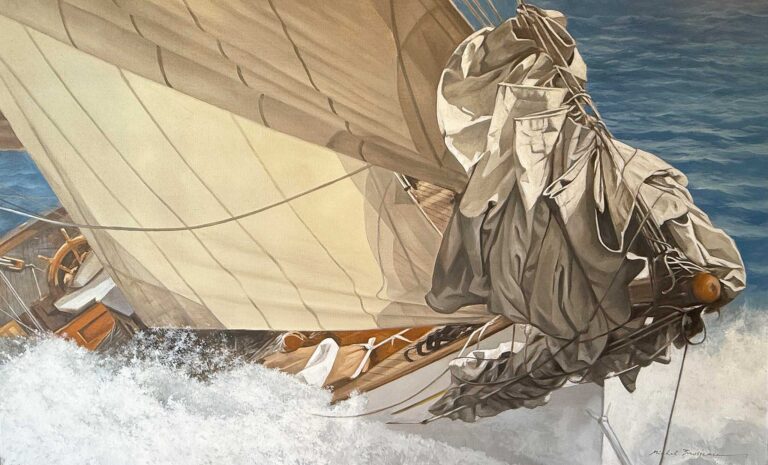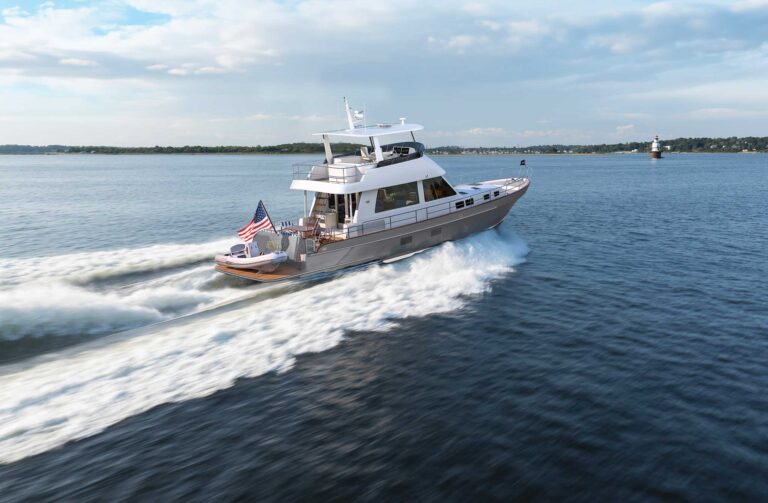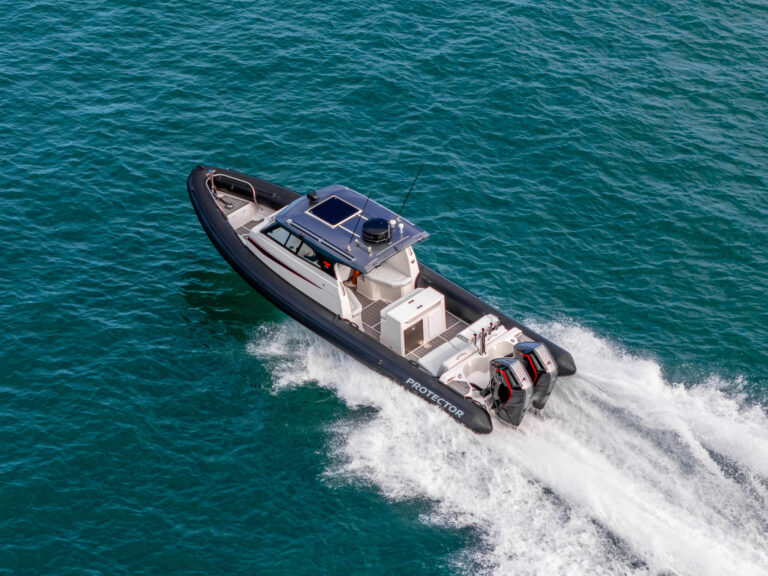
I’m willing to bet that we all, especially small sailboat operators, have an anecdote or two about astonishing tidal currents. Mariners with lots of horsepower may simply plow through a foul current—if they don’t mind burning a lot of fuel—and may be less inclined to do a little extra planning. For the rest of us with only modest power, however, avoiding a foul current and squeezing the best speed possible from the boat are crucial. Showing up late for a dinner invitation is harmless enough, but losing the ability to maneuver or being swept into danger can be tragic. Plan ahead. Good current, good speed, safe transit.
If you’ve come up the East Coast offshore, then you know the joys of the mighty Gulf Stream’s free miles for a fast trip. When you pay attention and stay in the fair current as long as possible heading north, you get two or more bonus miles each hour over the bottom. For slowpoke sailboats, 50 free miles a day over the bottom is significant, and for motoryachts, the fuel savings add up.
So, too, with coastal cruising. It’s easy enough to forecast the most favorable
currents and schedule your trip accordingly. This spring, I helped a friend come north up the coast, and we planned our arrival at Sandy Hook, New Jersey, to take advantage of a fair current through New York Harbor and the East River. Making short time of the New York City transit, we watched ourselves whiz past the joggers in Manhattan. I heard my shipmate mumble to no one in particular, “Damn, the last time I came through here, we were only doing 1 knot.” A little planning goes a long way, I thought, as I visualized the joggers running faster than his boat.
The NOAA Current Predictions can be found at tidesandcurrents.noaa.gov/noaacurrents/regions. You can click on your arrival state and location, or go to the tides and currents map to see predicted currents in tabular and graphical form.
Most onboard chartplotters and mobile navigation apps have current symbols that list the speed and direction in real-time. A click on the area’s icon usually offers planning information too. The Tides Near Me app has a useful recent-currents feature. In a pinch, you can anticipate ebb or flood using smartphone apps such as SailFlow, Windy or Windfinder. Just remember that predicted times of high and low tides may not exactly coincide with a location’s current flow.
Paperless mariners, please allow me to recommend a worthwhile exception: the Eldridge Tide and Pilot Book, now in its 147th year of publication. It is a quintessential annual gem, listing times and heights of high water for every day of the year at locations from Maine to Florida.
It lists slack, maximum flood and ebb times and velocities, current flow directions for base stations, and corrections for lesser subordinate locations along the entire East Coast. It has chart diagram pages that depict current velocities and directions for each hour of the flood and ebb for Long Island and Block Island Sounds, Buzzards Bay, Vineyard and Nantucket Sounds, Woods Hole, New York Bay and Chesapeake Bay.
Entertaining articles about emergencies, safety, rules of the road, lights, buoys, fog signals, weather prediction, electronic navigation and communications, and astronomical data are provided too. My personal favorite is the treatise on holding a fair current between Eastern Long Island and Nantucket. In places like Buzzards Bay and Vineyard Sound, currents often flow in opposite directions during certain hours of the daily cycles. Eldridge diagrams allow you to take advantage of the favorable reversed flows on alternate sides of the islands. So, too, in Eastern Long Island Sound, where the current diagrams show dramatic differences in velocity varying along the Connecticut and Long Island sides.
Predicting the current ahead of time also makes for the safest transit of confined waterways. Losing steerageway or being unable to get out of the way of a loaded commercial vessel puts the dangers of a furious current in all-too-frightening perspective for a small boat. Slack water, the brief interval between the opposing directions of the ebb and flooding flows, is often a wise choice for the underpowered boater.
I sailed an engineless 28-foot ketch for more than a decade in my youth. Trust me when I say that an engineless boat is the most effective way to become humble. Second only to predicting currents, the habit I acquired immediately was recognizing when the forces of nature may supersede the maneuvering power of the boat.
Once, with Hadley Harbor in Massachusetts as our destination for a meetup with friends, we checked and double-checked the currents in various cuts from Vineyard Sound to Buzzards Bay. We reached back and forth off the Woods Hole entrance, waiting for slack water and testing for the reassurance that a favorable quartering breeze would allow our transit. “Going with the flow,” was our mantra, and we felt we’d have enough boat speed to cover the mile and a half cut before the current picked up. It runs at 4 knots or more at maximum, and there is an intimidating 90-degree dogleg course change in the middle.
As soon as we passed the first set of buoys, the wind completely dropped out. We prayed. We whistled. When the breeze didn’t even try to stir, we felt that primal warning (if something feels weird in your gut, it usually is weird). Without headway, we couldn’t steer, and the current was rapidly building behind us.
We rigged a towline on the bow—our alternate plan B—and, fortunately, a lobster fisherman powered alongside us. He wryly said, “Are you sure this is the way you want to come through here?” We thankfully threw the towline into his cockpit.
Ah, youth. The moral of the story is: If your boat is underpowered, know your limitations, and don’t put yourself in harm’s way.
There are also situations where current is influenced by other factors not forecasted in your tidal charts or apps. Excessive rainfall will create amplified river flows and higher water levels. During conditions like this, it’s not unusual for navigation buoys to be swept underwater. Use caution and plan for extra maneuvering room that may require extra horsepower. Pass downstream of hazards. A good seaman responds early with piqued situational awareness, whereas a seat-of-the-pants mariner is rewarded with red or green paint scrapes along his topsides.
You can surely depend on the speed of the current to increase in any location where the land narrows into a bottleneck and constricts the flow of water. Remember Bernoulli’s principle from high school physics? It comes into play when a whole body of water is forced to ebb and flood though considerably narrowed geography. Harbor inlets do this too. A hard wind against the substantial current can stack up a steep, hair-raising chop in such rips. Small boats beware.
Besides making optimal speed to arrive at your destination before the hors d’oeuvres are gone, using current to your advantage feels satisfying. You are being as one with the natural elements. We go cruising to relax right? There’s nothing wrong with anchoring a bit to wait for the tide. If you plan it right, you’ll get some rest without compromising your ETA. One might simply slow down or delay departure to arrive at the right time to maximize favorable currents or to avoid getting beat up in a rip. It’s simple math, part of the art of navigation.
Utilizing current diagrams is intellectually rewarding too, like solving a puzzle. Avoid the hazards of strong currents, submerged buoys or pots, and dangerous docking scenarios by placing your boat in the right place at the right time. Do your wallet and the planet a favor by saving fuel. Go with the flow.
This article was originally published in the October 2021 issue.


